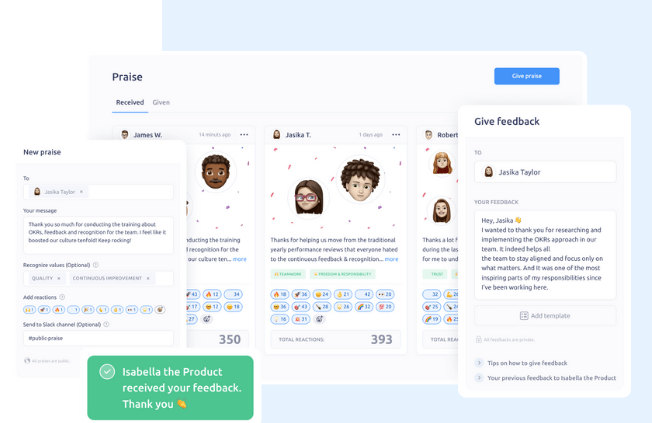
Can Reflektive help your company solve performance management problems? To support you in finding the answer to this question, we prepared a Reflektive review.
According to statistics, 85% of employees who receive weekly performance reviews are more engaged. However, an overwhelming 63% of companies still rely on annual employee evaluations. The numbers show the importance of having a continuous performance management process in place. But they also indicate that many businesses struggle to deploy it.
A performance management platform can be extremely helpful in creating a culture of accountability and continuous improvement, which leads to better outcomes for both the employee and the organization.
Therefore, many businesses turn to Reflexitve to find help in increasing employee engagement, enhancing productivity and facilitating feedback.
Though, if you want to start using the tool, you have to be prepared for a serious financial commitment. Is Reflektive really worth it? This article helps you find the answer to that question, so let's dive in.

Reflektive is a performance management software. The platform helps organizations streamline performance review processes, set goals, gather feedback, and enable continuous employee development. The software includes features such as goal management, real-time feedback, performance analytics, and 360-degree reviews.
Reflektive aims to enhance employee engagement, facilitate effective performance conversations, and drive organizational success by offering tools and insights to improve performance management practices.
Reflektive has many advantages, since it:
Still, user reviews reveal that some of the Reflektive features are unsatisfactory, for example:
Because Revflektive requires a lot of setup work, teams and customer success representatives often need to spend plenty of time together trying to determine the best way to use the tool.
Moreover, its capabilities of bringing together data and generating cohesive insights are limited. For these reasons, the performance management platform might not be suitable for all companies.
Following its acquisition by the Learning Technologies Group in January 2021, the future direction of Reflektive remains uncertain. Consequently, organizations prioritizing effective people management seek alternative solutions with lower procurement risk.
Finding performance management software that meets a company's needs is crucial because it directly impacts employee engagement, performance, and overall organizational success.
Each organization has unique goals, culture, and processes, and selecting the right software ensures a better fit, seamless implementation, and greater adoption by employees and managers.
Because of the downsides of the software we are discussing, many companies are taking a closer look at Reflektive competitors.

One of them is Plai – an all-in-one performance management software.
Let's see how those two platforms compare.
Reflektive and Plai Team are both performance management systems allowing users to create performance reviews, hold 1:1 meetings and access goals management features and feedback tools. Both platforms offer analytics and reporting features.
However, there are several differences between the two systems.
Plai's interface and user experience stand out as one of the best in the market. Because of the platform's intuitive nature, there's no need for extensive training or onboarding. One week is enough for most companies to implement Plai.
Plai provides built-in HR expert tips and templates, offering guidance and support for first-time managers and companies in the early stages of establishing their HR processes.
Additionally, Plai offers AI-based features that provide quick report analysis, smart AI suggestions for goals and feedback, and valuable insights about your organization and team.
A successful performance management strategy is continuous, allowing managers to find numerous opportunities to correct and reward team members. Therefore a robust performance management platform is indispensable in improving employee performance, accelerating business growth, and decreasing employee retention.
Plai is one of the best Reflektive alternatives, offering a more flexible pricing structure, ensuring continuous feedback and improving performance conversations. It supports your company in goal setting, improves the evaluation process and helps to identify and reward high-performing employees. The software offers seamless integration with calendars, HR systems, and identity management providers.
Sign up for a free trial to get a clear picture of how the Plai works. After the trial period, you can choose one of the affordable pricing plans. For example, if you are a small business owner, your monthly fee will be only $4 per user. Sounds good? Start using Plai today.
According to G2, Reflektive pricing starts at $7,500 a month, as a flat rate. Reflektive does not provide a free plan or trial.
A performance management system refers to a comprehensive framework or set of processes and tools designed to monitor, measure, and improve employee performance within an organization. It encompasses various activities related to goal setting, performance evaluation, feedback, coaching, and development planning.
A performance management system typically involves the following components:
See also: Why should you separate OKR and performance review
Related: How to make performance appraisal less stressful for employees
See also: 4 Steps to developing employee competencies matrix and why it matters
Performance management is an essential process in every organization, and it serves several purposes:
Related: Leadership performance review template and process explained
In this guide, you will find:
- OKR principles
- Formulas & scores
- OKR methodology
- Step-by-step guide
- Free OKR templates
- Common mistakes
Unlimited freemium for 14 days. Easy set up. No credit card required. 99% in customer satisfaction from G2 users.




Explore our comprehensive guide on the top 8 performance management software and find the tools offering the best route toward higher employee productivity.